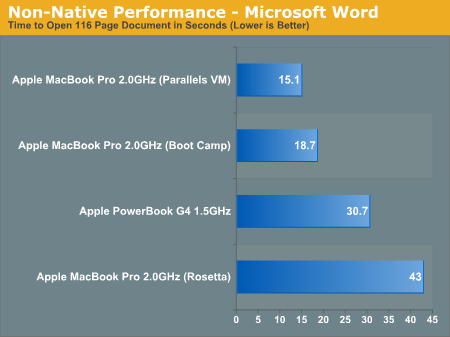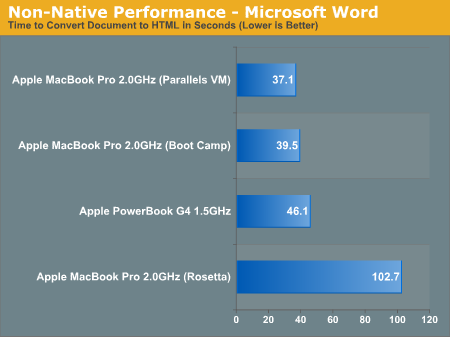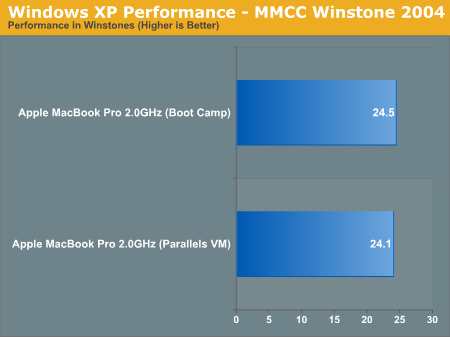Apple's MacBook Pro: Using it as a Mac and a PC
by Anand Lal Shimpi on April 13, 2006 12:00 AM EST- Posted in
- Mac
Rosetta vs. Boot Camp vs. VT
When the Intel based Macs were first introduced, the only option for running non-native binaries was through Rosetta, a binary translator. As we showed in our iMac Core Duo review, performance using Rosetta was pretty horrible, but that was compared to an iMac G5. Would someone upgrading from a PowerBook G4 really notice the performance difference between an application running natively on their G4 and an application running on top of Rosetta on a MacBook Pro?
To find out I ran the same MS Word tests I ran a couple of months ago on the iMac Core Duo, and compared the results between the native version of the application running on the PowerBook G4 and the Rosetta powered MacBook Pro. As an additional pair of reference points I also ran the same benchmark using Word 2003 on a Windows XP partition using Boot Camp as well as Parallels' Workstation VM.

Although Rosetta on the MacBook Pro wasn't that much worse than the G4 in opening the test document the HTML conversion process was significantly slower. What's truly impressive is how much faster everything is under both Boot Camp and running under Parallels' VM. Although we can't explain it, the VM consistently posted slightly faster times than under Boot Camp, although it wasn't perceivable other than by stopwatch.

What these tests show is a very interesting alternative to Rosetta - simply running the non-native application in Windows instead. While you don't get all of the benefits of running something in OS X, you do get a huge increase in performance. It's also quite impressive to see that the VM solution truly is basically as fast as running Windows XP natively using Boot Camp.
I dug a little deeper to see how the Boot Camp and VM offerings stood up to one another in a couple more tests. The first being a script that Intel uses to measure performance using Adobe Photoshop CS2 (if I could run the script under OS X I would, but it is not supported).

Once again the Parallels' Workstation VM manages to be a bit faster than Boot Camp, which doesn't exactly make sense but the results were consistent.
I wanted to run both sets of Winstone benchmarks but Business Winstone 2004 consistently failed to complete running in the VM. The applications themselves didn't crash but I suspect there may have been a timing issue related to the VM. Luckily, I could at least get Multimedia Content Creation Winstone running and got a set of results from it:

While Boot Camp is slightly faster, the difference is hardly noticeable. This is quite an important benchmark because it shows that disk as well as CPU performance isn't hampered by running Windows XP on a virtual machine. Unfortunately what these benchmarks don't measure is the responsiveness of the UI, which truly does suffer under the VM option.










52 Comments
View All Comments
Calin - Thursday, April 13, 2006 - link
This could be thanks to slower drivers in BootCamp Windows XP, or slower hard drive access/speed. Everything else is a disadvantage for VM: one more level of indirection in disk access, less memory, running the OS X behind the VM.Could you do some disk speed comparation between VM and native XP?
BigLan - Thursday, April 13, 2006 - link
I think it's going to be hard drive speed throwing off the benchmarks. The BootCamp partition is going to be at the outer edge of the disk, with much slower speeds than the VM client virtual drive which is on the faster Apple partition.I'm not sure if it's possible to assign the entire HD to a windows partition using Bootcamp, but that's about the only way i can think of to level the playing field.
Calin - Friday, April 14, 2006 - link
To nitpick, it would be at the center of the hard drive, not at the outer edge :) (ok, based on sector numbers, which starts at the edge).Near the "end" of the hard drive, the transfer speed is reduced (there are fewer bytes on a full circle).
jimmy43 - Thursday, April 13, 2006 - link
Excellent Review. This may be my first laptop purchase, seems to have everything I could possibly want.monsoon - Thursday, April 13, 2006 - link
Hello Anand,...i'm waiting for Parallels to finalize their VT release and maybe Merom Macs too...
I was wondering if the ONE CORE only VT tech is to be the final result of their virtualization software or just a middle-step.
Seems to me it's rather poor a solution ( ok, it's the best out there for now ) to use a dual-core computer to run both OS on a single core
=/
Better would be smart distribution of tasks to the CPU depending on which OS is actually under load...
...any thoughts / info on that ?
Thanks for your nice review !=)
plinden - Thursday, April 13, 2006 - link
Looking at CPU load while running Parallels VM, I see the load spread evenly over both processors (usually < 10% total CPU except at boot, when it reaches 150% CPU). It's just that the VM itself sees itself as running on a single processor.
shuttleboi - Thursday, April 13, 2006 - link
I've read that the ATI X1600 in the Mac can run games well, but only IF you overclock the GPU. I can't imagine the Mac getting any hotter than it already supposedly is, and the idea of overclocking an already hot laptop is not appealing.JoKeRr - Thursday, April 13, 2006 - link
Overall I enjoyed it.Would have been nice to see a comparison of screen brightness, as apple claimed 67% brighter!
And also, the slowness in windows, could it be related to chipset driver stuff?? And what's the gaming experience so far like?? Would it be similar to a desktop 6600 or 6600gt??
Thank you.
rolls - Friday, April 14, 2006 - link
Very interesting numbers all round.35% improvement in iTunes when comparing a single core 1.5GHz 7447 with the old slow bus etc, and a new 33% faster dual core intel CPU. 50% improvement in H.264 encoding etc. These numbers suggest that had Apple stuck with Freescale and moved to e600 core based systems, performance figures could have been off the scale. If only...
JarredWalton - Thursday, April 13, 2006 - link
On paper the X1600 Pro desktop cards actually look pretty decent. 12 pipelines at 500 MHz, with 800 MHz RAM. I would have thought they would at least give the 6600GT a run for the money, given how X1800 compares to 7800. Amazingly (to me), the X1600 gets completely stomped by the 6600GT. What's worse, the cards I have can't even overclock worth a darn on the memory side - 800 is stock, and they get unstable at even minor changes. (Could be an issue with the overclocking tool, though?)Anyway, for now I would say X1600 Mobility is going to be somewhere in the realm of 6600 (non-GT) performance, maybe slightly faster. That means gaming is definitely possible, but you will want low-to-medium detail levels for any recent titles. Just a guess, of course, and Anand will have to run benches to get any final confirmation. Really, though, this laptop isn't intended as anything more than a light gaming solution.